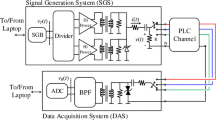Abstract
The broadband power line communication (BPLC) is designed under severe propagation constraints with devices of low cost, which provides integrated operation with other such devices, mainly the spatial and temporal variation of input side impedance. Adaptive impedance matching circuits have been proposed in this study, and most are designed for BPLC. The range of operating frequency and various proposals of impedance matching techniques are studied, and a new structure of the circuit is introduced. The impedance mismatch between the transmission line and the recipient reduces the signal-to-noise-power ratio at the receiver. A fixed matching circuit will be wasteful when the access impedance fluctuates. In other words, the system suggested in this paper offers a mechanism for adaptive improvement that best matches the transmission and receipt of signal flows. The system is assessed using simulations for various access impedance test sites and S-parameters of BPLC networks. Our simulation results showed that, within 20% of the theoretical optimum, the adaptive matching method presented could match signal power transfer. This corresponds to up to ten times higher power than other literary solutions. Motivation: Increasing demand for broadband signal in different media viz audio, video/image, and the internet has led to the development of wireless/wireline technology processing with a high growth rate. Advanced signal processing techniques now enable megabits per second to be carried over this extremely hostile channel, viz residential power wiring. There is a shortfall in data rate if the load is inductive in BPLC. Although there are many impedance matching techniques, one of the most significant complications they face is their static nature, i.e., they are designed to match a particular load. Contribution: The matching circuitry and sensor and control unit for the adjustment of circuit components is part of an adaptive impedance system. The technique suggested achieves a signal transmission close to an optimum match. The overall power transfer increases are reached by up to 10 dB.









Similar content being viewed by others
Availability of data and materials
There is no availability of data or materials needed for the manuscript.
Abbreviations
- CS1,2:
-
Capacitor in series
- LS1,2:
-
Inductor in series
- LP 1,2:
-
Inductor in parallel
- CP1,2:
-
Capacitor in parallel
- VCGIC:
-
Voltage controlled impedance converter
- BPLC:
-
Broad band powerline communication
- BPF:
-
Bandpass filter
References
Araneo R, Celozzi S, Lovat G (2009) Design of impedance matching couplers for power line communications. In: 2009 IEEE International Symposium on Electromagnetic Compatibility, pp 64–69
Choi W, Park C (2007) A simple line coupler with adaptive impedance matching for power line communication. In: 2007 IEEE International Symposium on Power Line Communications and Its Applications, pp 187–191
Ferreira HC, Lampe L, Newbury J, Swart TG (2011) Power line communications: theory and applications for narrowband and broadband communications over power lines. John Wiley & Sons, New Jersey
Godara B, Fabre A (2007) Versatile wideband impedance matching circuit based on current conveyors. Electron Lett 43(6):341–343
Gouret W, Nouvel F, El-Zein G (2007) Powerline communication on automotive network. In: 2007 IEEE 65th Vehicular Technology Conference-VTC2007-Spring, pp 2545–2549
Gu Q, Luis JRD, Morris AS, Hilbert J (2011) An analytical algorithm for pi-network impedance tuners. IEEE Trans Circuits Syst I 58(12):2894–2905
Huang ZY, Huang CC, Chen MP, Hung YT (2008) Design considerations on input impedance matching for ultra-wideband low-noise amplifier. In: 2008 International Conference on Microwave and Millimeter Wave Technology, pp 245–248
Huck T, Schirmer J, Hogenmuller T, Dostert K (2005) Tutorial about the implementation of a vehicular high speed communication system. Int Symp Power Line Commun Appl 2005:162–166
Issa F, Goldberg M, Li H, Rowland S (2005) Wideband impedance matching using Tchebycheff gain functions. Int Symp Power Line Commun Appl 2005:278–280
Iyer V, Makarov SN, Harty DD, Nekoogar F, Ludwig R (2009) Lumped circuit for wideband impedance matching of a non-resonant, short dipole or monopole antenna. IEEE Trans Antennas Propag 58(1):8–26
Leen G, Heffernan D (2002) Expanding automotive electronic systems. Computer (long. Beach Calif.) 35(1):88–93
Leuciuc A, Goras L (1998) New general immittance converter JFET voltage-controlled impedances and their applications to controlled biquads synthesis. IEEE Trans Circuits Syst I 45(6):678–682
Lienard M, Carrion MO, Degardin V, Degauque P (2008) Modelling and analysis of in-vehicle power line communication channels. IEEE Trans Veh Technol 57(2):670–679
Mavretic A, Ciszek A, Stach J (1997) Apparatus for matching a variable load impedance with an RF power generator impedance. Aug. 5 1997, US Patent 5,654,679
Mohammadi M, Lampe L, Lok M, Mirabbasi S, Mirvakili M, Rosales R, Van Veen P, (2009) Measurement study and transmission for in-vehicle power line communication. In: 2009 IEEE International Symposium on Power Line Communications and Its Applications pp 73–78
Munoz F, Carvajal RG, Torralba A, Franquelo LG, Ramos EZ and Pinilla J (1999a) ADAPT: mixed-signal ASIC for impedance adaptation in power line communications using fuzzy logic. In: IECON’99 Conference Proceedings: 25th Annual Conference of the IEEE Industrial Electronics Society (Cat. No. 99CH37029), pp 509–513
Munoz F, Carvajal RG, Torralba A (1999b) ADAPT: mixed-signal ASIC for impedance adaptation in power line communications using fuzzy logic. In: Proceedings of the 25th Annual Conference of the IEEE Industrial Electronics Society, San Jose, USA, 29 November-3 December 1999
Nisbet P, He M, Zhao L (2014) Transformerless impedance matching networks for automotive power line communication. J Electr Electron Eng Res 6(2):13–20
Park C, Jung K, Choi W (2008a) Coupling circuitary for impedance adaptation in power line communications using VCGIC. In: IEEE International Symposium on Power Line Communications and Its Applications (ISPLC), Jeju, Korea pp 293–298
Park CY, Jung KH, Choi WH (2008b) Coupling circuitry for impedance adaptation in power line communications using VCGIC. In: 2008 IEEE International Symposium on Power Line Communications and Its Applications pp 293–298
Razavi B (2002) Design of analog CMOS integrated circuits. Tata McGraw-Hill Education, New York
Rensburg PAJV, Ferreira HC (2003) Automotive power-line communications: Favourable topology for future automotive electronic trends. In: Proceedings of the International Symposium on Power Line Communications and Its Applications (ISPLC) pp 103–108
Rensburg PAJV, Ferreira HC (2004) Step-by-step design of a coupling circuit with bi-directional transmission capabilities. In: Proceedings of 8th International Symposium Power-Line Comm pp 238–243
Rensburg PAJV, Ferreira HC (2005) Design of a bidirectional impedance-adapting transformer coupling circuit for low-voltage power-line communications. IEEE Trans Power Deliv 20(1):64–70
Rensburg PAJV, Ferreira HC (2007) Coupler winding ratio selection for effective narrowband power-line communications. IEEE Trans Power Deliv 23(1):140–149
Rensburg PAJV, Ferreira HC (2009) Design and evaluation of a dual impedance-adapting power-line communications coupler. IEEE Trans Power Deliv 25(2):667–673
Rensburg PAJV, Sibanda MP, Ferreira HC (2014) Integrated impedance-matching coupler for smart building and other power-line communications applications. IEEE Trans Power Deliv 30(2):949–956
Sibanda MP, Rensburg PAJV and Ferreira HC (2009a) Passive, transformerless coupling circuitry for narrow-band power-line communications. In: 2009 IEEE International Symposium on Power Line Communications and Its Applications pp 125–130
Sibanda MP, Rensburg PAJV, Ferreira HC (2009b) Passive, transformerless coupling circuitry for narrow-band power-line communications. In: 2009 IEEE International Symposium on Power Line Communications and Its Applications pp 125–130
Sibanda MP, Rensburg PAJV, Ferreira HC (2011) Impedance matching with low-cost, passive components for narrowband PLC. In: 2011 IEEE International Symposium on Power Line Communications and Its Applications pp 335–340
Sibanda MP, Rensburg PAJV, Ferreira HC (2013) A compact economical PLC band-pass coupler with impedance matching. In: 2013 IEEE 17th International Symposium on Power Line Communications and Its Applications pp 339–344
Stornelli V, Ferri G, Leuzzi G, De Marcellis A (2006) A tunable 0.5–1.3 GHz CMOS 2nd order bandpass filter with 50/spl Omega/input-output impedance matching. In: 2006 IEEE International Symposium on Circuits and Systems pp 4
Taherinejad N, Rosales R, Mirabbasi S, Lampe L (2011) A study on access impedance for vehicular power line communications. In: 2011 IEEE International Symposium on Power Line Communications and Its Applications pp 440–445
Taherinejad N, Rosales R, Mirabbasi S, Lampe L (2012) On the design of impedance matching circuits for vehicular power line communication systems. In: 2012 IEEE international symposium on power line communications and its applications pp 322–327
Wang B, Cao Z, Luan Z, Zhou B (2019) Design and evaluation of band-pass matching coupler for narrow-band DC power line communications. J Circuits Syst Comput 28(07):1950119
Yarman BS, Şengül M, Trabert J, Blau K, Hein M (2006) Design of wideband matching networks for wireless communication systems. In: International Symposium on Communications, Control and Signal Processing
Yuan F (2008) CMOS active inductors and transformers. Principle, implementation, and applications. Springer, Berlin
Funding
No funding is made available for the preparation of the paper.
Author information
Authors and Affiliations
Contributions
Author DSG contributes the data search ability and data curability. Author KRUR contributes to project administration and result curation.
Corresponding author
Ethics declarations
Conflict of interest
Neither conflict of interest exists between the authors in preparing and submitting manuscripts. There is no competing interest between the authors regarding the manuscript preparation.
Ethical approval
No experiments with human participants or animals undertaken by the authors are contained in this publication.
Informal consent
All people included in the study provided informed consent.
Consent to participate
There is no consent to participate or any concerns in the manuscript.
Consent to publish
There is no consent or any copyright needed to get concerns in the manuscript.
Additional information
Publisher's Note
Springer Nature remains neutral with regard to jurisdictional claims in published maps and institutional affiliations.
Rights and permissions
About this article
Cite this article
Gayathri, D.S., Rani, K.R.U. Adaptive impedance matching system for broadband power line communication using RC-filters. J Ambient Intell Human Comput 14, 11823–11832 (2023). https://doi.org/10.1007/s12652-022-03738-8
Received:
Accepted:
Published:
Issue Date:
DOI: https://doi.org/10.1007/s12652-022-03738-8




